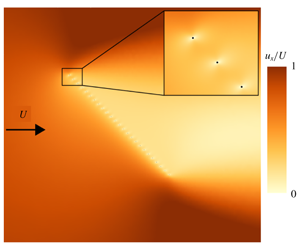Crossref Citations
This article has been cited by the following publications. This list is generated based on data provided by
Crossref.
Lahooti, Mohsen
and
Kim, Daegyoum
2020.
Unsteady concentration transport over an array of cylinders in low-Reynolds-number flow.
Physics of Fluids,
Vol. 32,
Issue. 5,
Lee, Minhyeong
Lee, Seung Hun
and
Kim, Daegyoum
2020.
Stabilized motion of a freely falling bristled disk.
Physics of Fluids,
Vol. 32,
Issue. 11,
Kolomenskiy, Dmitry
Farisenkov, Sergey
Engels, Thomas
Lapina, Nadezhda
Petrov, Pyotr
Lehmann, Fritz-Olaf
Onishi, Ryo
Liu, Hao
and
Polilov, Alexey
2020.
Aerodynamic performance of a bristled wing of a very small insect.
Experiments in Fluids,
Vol. 61,
Issue. 9,
Engels, Thomas
Kolomenskiy, Dmitry
and
Lehmann, Fritz-Olaf
2021.
Flight efficiency is a key to diverse wing morphologies in small insects.
Journal of The Royal Society Interface,
Vol. 18,
Issue. 183,
Wu, Yu Kai
Liu, Yan Peng
and
Sun, Mao
2021.
Unsteady aerodynamics of a model bristled wing in rapid acceleration motion.
Physics of Fluids,
Vol. 33,
Issue. 11,
Wu, Yu Kai
Liu, Yan Peng
and
Sun, Mao
2021.
Aerodynamics of two-dimensional bristled wings in low-Reynolds-number flow.
AIP Advances,
Vol. 11,
Issue. 4,
Kasoju, Vishwa T.
and
Santhanakrishnan, Arvind
2021.
Aerodynamic interaction of bristled wing pairs in fling.
Physics of Fluids,
Vol. 33,
Issue. 3,
Kasoju, Vishwa T
and
Santhanakrishnan, Arvind
2021.
Pausing after clap reduces power required to fling wings apart at low Reynolds number.
Bioinspiration & Biomimetics,
Vol. 16,
Issue. 5,
p.
056006.
Lee, Seung Hun
and
Kim, Daegyoum
2021.
Aerodynamic response of a bristled wing in gusty flow.
Journal of Fluid Mechanics,
Vol. 913,
Issue. ,
Galler, Joshua N
and
Rival, David E
2021.
Characterization of milkweed-seed gust response.
Bioinspiration & Biomimetics,
Vol. 16,
Issue. 6,
p.
066017.
Wu, Yu Kai
Liu, Yan Peng
and
Sun, Mao
2022.
Aerodynamics of two parallel bristled wings in low Reynolds number flow.
Scientific Reports,
Vol. 12,
Issue. 1,
O’Callaghan, Felicity
Sarig, Amir
Ribak, Gal
and
Lehmann, Fritz-Olaf
2022.
Efficiency and Aerodynamic Performance of Bristled Insect Wings Depending on Reynolds Number in Flapping Flight.
Fluids,
Vol. 7,
Issue. 2,
p.
75.
Farisenkov, Sergey E.
Kolomenskiy, Dmitry
Petrov, Pyotr N.
Engels, Thomas
Lapina, Nadezhda A.
Lehmann, Fritz-Olaf
Onishi, Ryo
Liu, Hao
and
Polilov, Alexey A.
2022.
Novel flight style and light wings boost flight performance of tiny beetles.
Nature,
Vol. 602,
Issue. 7895,
p.
96.
Wu, Yu Kai
Sun, Mao
and
Liu, Yan Peng
2022.
The wing−wing interaction mechanism of bristled wing pair in fling motion.
Physics of Fluids,
Vol. 34,
Issue. 7,
Kolomenskiy, Dmitry
2023.
Recent Progress in the Biomechanics of Flight of Miniature Insects with Bristled Wings.
Journal of the Physical Society of Japan,
Vol. 92,
Issue. 12,
2023.
Rarefaction effect on the aerodynamics of bristled wings in miniature insects.
Physics of Fluids,
Vol. 35,
Issue. 5,
Luna Lin, Yuexia
Pezzulla, Matteo
and
Reis, Pedro M.
2023.
Fluid–structure interactions of bristled wings: the trade-off between weight and drag.
Journal of The Royal Society Interface,
Vol. 20,
Issue. 206,
O’Callaghan, Felicity
and
Lehmann, Fritz-Olaf
2023.
Flow development and leading edge vorticity in bristled insect wings.
Journal of Comparative Physiology A,
Vol. 209,
Issue. 2,
p.
219.
Dong, Yangyang
Ni, Yuyang
Hu, Kexin
Zhang, Tongle
Zhang, Zijian
and
Wang, Yongbin
2023.
Transition to turbulence in the wake of dandelion-like spoke disk.
Physics of Fluids,
Vol. 35,
Issue. 10,
Sun, Mao
2023.
Colloquium
: Miniature insect flight.
Reviews of Modern Physics,
Vol. 95,
Issue. 4,
